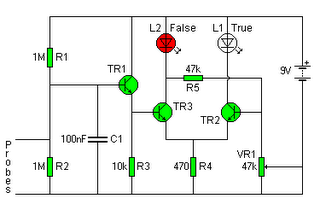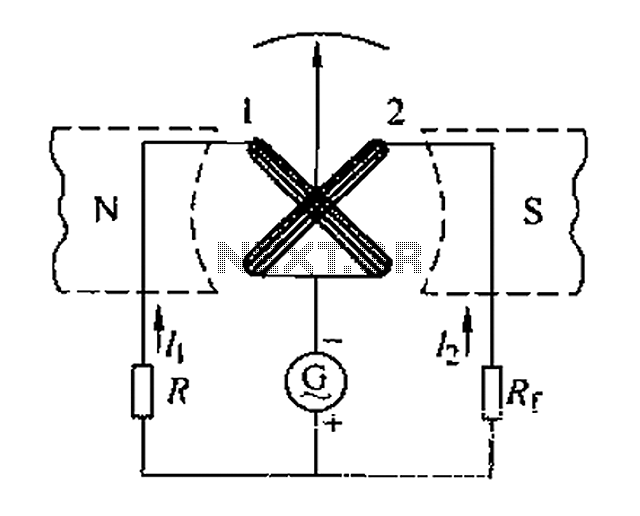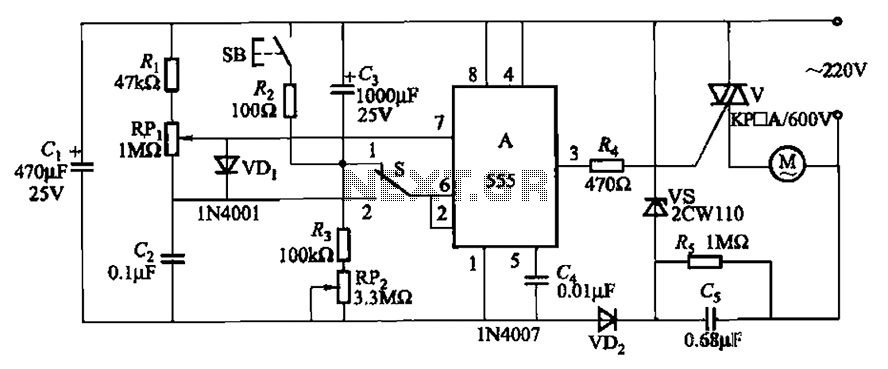
light flasher/blinker circuit diagram

When the preset is set to its maximum, the LED flashes at a rate of approximately once every half second. This rate can be increased by raising the capacitor value from 10µF to a higher value. For instance, if the capacitor is increased to 22µF, the flashing rate changes to one second. There is also an option to convert the circuit into an alternating flasher by connecting an LED and a 330Ω resistor to points X and Y in the schematic. In this configuration, both LEDs will flash alternately. The 555 timer can supply or sink up to 200mA of current, allowing for the connection of approximately 18 LEDs in parallel for both the standard flasher and the alternating flasher, resulting in a total of 36 LEDs for the alternating flasher.
The described circuit utilizes a 555 timer IC configured in astable mode to create a flashing LED effect. The frequency of the LED flashing is determined by the resistor-capacitor (RC) timing network, which consists of a resistor connected to the discharge pin and a capacitor connected between the threshold pin and ground. The preset resistor allows for fine-tuning of the flashing rate.
When the capacitor value is increased, the time constant of the RC network also increases, leading to a longer flash duration. The circuit's output can drive multiple LEDs in parallel, as the 555 timer can handle a maximum output current of 200mA. This is particularly useful for applications requiring multiple indicators.
For the alternating flasher configuration, the addition of a second LED and a 330Ω resistor facilitates the alternating flashing behavior. This is achieved by connecting the second LED in series with the resistor to the output of the 555 timer, allowing it to switch states with the first LED.
The total number of LEDs that can be connected in parallel is dependent on the current output limit of the 555 timer. With a maximum of 200mA, dividing this current by the forward current rating of each LED (typically around 20mA) allows for the connection of up to 10 LEDs in parallel for continuous operation. However, in an alternating configuration, this can be effectively doubled, permitting up to 36 LEDs to flash alternately without exceeding the current limits of the 555 timer.
The circuit design is suitable for various applications, including decorative lighting, indicators, and alert systems, where visual signaling is required. Proper heat dissipation and current limiting resistors should be considered in the final implementation to ensure reliability and longevity of the LEDs.With the preset at its max. the flashing rate of the LED is about 1/2 a second. It can be increased by increasing the value of the capacitor from 10uF to a higher value. For example if it is increased to 22uF the flashing rate becomes 1 second. There is also provision to convert it into an alternating flasher. You just have to connect a LED and a 330ohm as shown in Fig. 2 to the points X and Y of Fig. 1. Then both the LEDs flash alternately. Since the 555 can supply or sink in upto 200mA of current, you can connect upto about 18 LEDS in parallel both for the flasher and alternating flasher (that makes a total of 36 LEDs for alternating flasher). 🔗 External reference
The described circuit utilizes a 555 timer IC configured in astable mode to create a flashing LED effect. The frequency of the LED flashing is determined by the resistor-capacitor (RC) timing network, which consists of a resistor connected to the discharge pin and a capacitor connected between the threshold pin and ground. The preset resistor allows for fine-tuning of the flashing rate.
When the capacitor value is increased, the time constant of the RC network also increases, leading to a longer flash duration. The circuit's output can drive multiple LEDs in parallel, as the 555 timer can handle a maximum output current of 200mA. This is particularly useful for applications requiring multiple indicators.
For the alternating flasher configuration, the addition of a second LED and a 330Ω resistor facilitates the alternating flashing behavior. This is achieved by connecting the second LED in series with the resistor to the output of the 555 timer, allowing it to switch states with the first LED.
The total number of LEDs that can be connected in parallel is dependent on the current output limit of the 555 timer. With a maximum of 200mA, dividing this current by the forward current rating of each LED (typically around 20mA) allows for the connection of up to 10 LEDs in parallel for continuous operation. However, in an alternating configuration, this can be effectively doubled, permitting up to 36 LEDs to flash alternately without exceeding the current limits of the 555 timer.
The circuit design is suitable for various applications, including decorative lighting, indicators, and alert systems, where visual signaling is required. Proper heat dissipation and current limiting resistors should be considered in the final implementation to ensure reliability and longevity of the LEDs.With the preset at its max. the flashing rate of the LED is about 1/2 a second. It can be increased by increasing the value of the capacitor from 10uF to a higher value. For example if it is increased to 22uF the flashing rate becomes 1 second. There is also provision to convert it into an alternating flasher. You just have to connect a LED and a 330ohm as shown in Fig. 2 to the points X and Y of Fig. 1. Then both the LEDs flash alternately. Since the 555 can supply or sink in upto 200mA of current, you can connect upto about 18 LEDS in parallel both for the flasher and alternating flasher (that makes a total of 36 LEDs for alternating flasher). 🔗 External reference
Warning: include(partials/cookie-banner.php): Failed to open stream: Permission denied in /var/www/html/nextgr/view-circuit.php on line 713
Warning: include(): Failed opening 'partials/cookie-banner.php' for inclusion (include_path='.:/usr/share/php') in /var/www/html/nextgr/view-circuit.php on line 713





